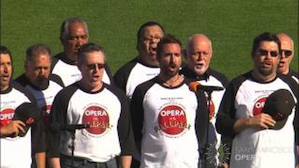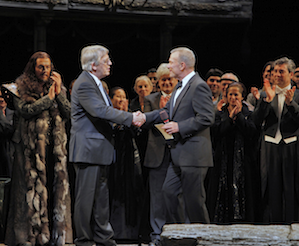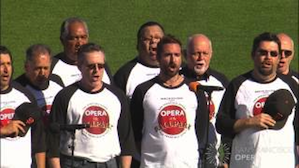
Instead of admiring the chandelier at the next Sunday matinee, I was once again reveling in the sound of the Opera Chorus, which sounds so amazing in Lohengrin. As often in the past, Chorus Director Ian Robertson added extra choristers to the regular chorus, 32 singers in this case. Can they be called "extras"? Yes, says SFO Chorus veteran Tom Reed:
They are officially called Extra Choristers. They include one GAX (Guaranteed Auxiliary Chorister) and one PEX (Preferred Extra Chorister) — the latter being me, now that I am happily semi-retired. I try not to use the "Preferred" terminology out of an extremely well-developed sense of modesty honed over three plus decades in the regular chorus.
Obviously, the addition of singers has advantage for the big fortissimo sounds, but what about the almost whispered passages, such as on Lohengrin's arrival? The more voices, the more difficult to keep it all together. In this case, the usual eight-part division (first and second sopranos, mezzos, contraltos, first and second tenors, baritones, and basses) is doubled because the ensemble is divided into Chorus 1 and Chorus 2, singing separate parts. On top of that, individual sections occasionally are split within themselves, as when Chorus 1 second tenors are divided in two, singing different notes.

This chorus does all that fabulously, filling the house. Robertson's expertise, Luisotti's own background in choral conducting, and lots of hard work add up to excellence. Also, Reed adds:
Part of the reason we are able to fill the house with our sound, despite having fewer singers on stage than I believe Luisotti would like, is that in this production we are closer to the front of the stage, sending less of our sound into the wings and tower above. And we are helped to some degree by the reflectivity of the set.Then, too, we are constantly being instructed by Ian [Robertson] to "cheat out," meaning to turn our heads toward the audience when we sing instead of facing the person to whom we are singing. It's a constant struggle to get everyone to do this in the midst of busy staging. But turning the head away from the audience even a little causes the chorus volume to drop considerably. And of course whenever the set contains steps upon which to stand, fewer choristers are singing directly into the person in front of them. Plus these costumes are not as sound-absorbing as are many in other productions.
Robertson's response to the accolades:
I'm overjoyed by the quality and character of the sound of the Opera Chorus this year, especially in Lohengrin. The chorus' ability to sound entirely homogenous in both strong and hushed passages testifies to each singer's vocal prowess and flexibility. Their palpable energy, their ability to satisfy the visions of both conductor and stage director, their understanding of the music and their immersion in character on stage are hallmarks of the best opera choruses in the world.
Amen from here, and — as it is happily mandatory this week to keep referring to the World Champions, at least in this part of the world — behold the Opera Chorus singing the National Anthem before a Giants game in AT&T Park.
As for connecting chorus and chandelier: Robertson in the years of working with the Opera since 1987 says he has never noticed the dimming-in-pattern. Of course, he may be busy otherwise; no excuse for the likes of me, sitting idly in the audience.

